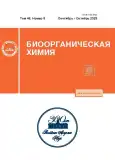Dynamics of Storage Lipids during the Recovery of Partially Bleached Coral Sinularia heterospiculata
- Authors: Sikorskaya T.V.1, Solodiy D.D.1,2, Maskin E.V.1,2
-
Affiliations:
- Zhirmunsky National Scientific Center of Marine Biology, Far Eastern Branch, Russian Academy of Sciences
- Far Eastern Federal University, Department of Biochemistry and Biotechnology
- Issue: Vol 49, No 5 (2023)
- Pages: 488-493
- Section: Articles
- URL: https://journals.rcsi.science/0132-3423/article/view/139252
- DOI: https://doi.org/10.31857/S0132342323050068
- EDN: https://elibrary.ru/AQFLLS
- ID: 139252
Cite item
Full Text
Abstract
Global warming is causing the loss of coral symbionts and their bleaching. Researches of coral recovery are very important for the conservation of coral reefs. The lipidomic approach can provide detailed information about the processes that take place in the coral during bleaching and recovery. Using supercritical fluid chromatography in combination with mass-spectrometry, the dynamics of the main classes of storage lipids triacylglycerols (TG) and monoalkyldiacylglycerols (MADAG) during the recovery of the octocoral Sinularia heterospiculata after heat stress (32°C). It was shown that MADAG plays an important role in the energy balance of S. heterospiculata after heat stress. Under stress, the coral S. heterospiculata primarily consumed saturated MADAG molecular species. Changes in the profile of TG molecular species occurred only on the 16th day of the experiment. Probable, the stressed octocoral S. heterospiculata changes its energy strategy during recovery; therefore, the qualitative composition of reserve lipids is rearranged during the recovery period.
About the authors
T. V. Sikorskaya
Zhirmunsky National Scientific Center of Marine Biology, Far Eastern Branch, Russian Academy of Sciences
Email: miss.tatyanna@yandex.ru
Russia, 690041, Vladivostok, ul. Palchevskogo 17
D. D. Solodiy
Zhirmunsky National Scientific Center of Marine Biology, Far Eastern Branch, Russian Academy of Sciences; Far Eastern Federal University, Department of Biochemistry and Biotechnology
Email: miss.tatyanna@yandex.ru
Russia, 690041, Vladivostok, ul. Palchevskogo 17; Russia, 690922, Vladivostok, Ajaks 10
E. V. Maskin
Zhirmunsky National Scientific Center of Marine Biology, Far Eastern Branch, Russian Academy of Sciences; Far Eastern Federal University, Department of Biochemistry and Biotechnology
Email: miss.tatyanna@yandex.ru
Russia, 690041, Vladivostok, ul. Palchevskogo 17; Russia, 690922, Vladivostok, Ajaks 10
References
- Spalding M.D., Grenfell A.M. // Coral Reefs. 1997. V. 16. P. 225–230. https://doi.org/10.1007/s003380050078
- Fabricius K., Alderslade P. // Soft Corals and Sea Fans: a Comprehensive Guide to the Tropical Shallow Water Genera of the Central-West Pacific, the Indian Ocean and the Red Sea. Townsville, Australia: Australian Institute of Marine Science, 2001. P. 77–103.
- Rowley S.J., Robert T.E., Coleman R.R., Spalding H.L., Joseph E., Dorricott M.K.L. // Pohnpei, Federated States of Micronesia. In: Mesophotic Coral Ecosystems / Eds. Loya Y., Puglise K.A., Bridge T.C.L. Springer International Publishing, Cham, 2019. V. 12. P. 301–320. https://doi.org/10.1007/978-3-319-92735-0_17
- McLachlan R.H., Price J.T., Solomon S.L., Grottoli A.G. // Coral Reefs. 2020. V. 39. P. 885–902. https://doi.org/10.1007/s00338-020-01931-9
- Oliver T.A., Palumbi S.R. // Coral Reefs. 2011. V. 30. P. 429–440. https://doi.org/10.1007/s00338-011-0721-y
- Yamashiro H., Oku H., Higa H., Chinen I., Sakai K. // Comp. Biochem. Physiol. B Biochem. Mol. Biol. 1999. V. 122. P. 397–407. https://doi.org/10.1016/S0305-0491%2899%2900014-0
- Imbs A.B., Dang L.P.T., Nguyen K.B. // PLoS One. 2019. V. 14. e0215759. https://doi.org/10.1371/journal.pone.0215759
- Hamoutene D., Puestow T., Miller-Banoub J., Wareham V. // Coral Reefs. 2008. V. 27. P. 237–246. https://doi.org/10.1007/s00338-007-0318-7
- Imbs A.B., Ermolenko E.V., Grigorchuk V.P., Dang L.T.P. // Coral Reefs. 2021. V. 40. P. 719–734. https://doi.org/10.1007/s00338-021-02073-2
- Sikorskaya T.V., Ermolenko E.V., Efimova K.V. // Coral Reefs. 2022. V. 41. P. 277–291. https://doi.org/10.1007/s00338-022-02222-1
- Imbs A.B. // Russ. J. Mar. Biol. 2013. V. 39. P. 153–168. https://doi.org/10.1134/s1063074013030061
- Yamashiro H., Oku H., Onaga K. // Fisheries Science. 2005. V. 71. P. 448–453. https://doi.org/10.1111/j.1444-2906.2005.00983.x
- Sikorskaya T.V., Ermolenko E.V., Imb, A.B. // J. Exp. Mar. Biol. Ecol. 2020. V. 524. 151295. https://doi.org/10.1016/j.jembe.2019.151295
- Imbs A.B. // Biochem. Syst. Ecol. 2014. V. 54. P. 213–218. https://doi.org/10.1016/j.bse.2014.01.016
- Imbs A.B., Latyshev N.A., Dautova T.N., Latypov Y.Y. // Mar. Ecol. Prog. Ser. 2010. V. 409. P. 65–75. https://doi.org/10.3354/meps08622
- Imbs A.B., Yakovleva I.M., Pham L.Q. // Fisheries Science. 2010. V. 76. P. 375–380. https://doi.org/10.1007/s12562-009-0213-y
- Joseph J.D. // Prog. Lipid Res. 1979. V. 18. P. 1–30. https://doi.org/10.1016/0163-7827(79)90002-X
- Sikorskaya T.V., Ermolenko E.V., Boroda A.V., Ginanova T.T. // Comp. Biochem. Physiol. B Biochem. Mol. Biol. 2021. V. 255. P. 110609. https://doi.org/10.1016/j.cbpb.2021.110609
- Grottoli A.G., Warner M.E., Levas S.J., Aschaffenburg M.D., Schoepf V., McGinley M., Baumann J., Matsui Y. // Global Change Biology. 2014. V. 20. P. 3823–3833. https://doi.org/10.1111/gcb.12658
- Folch J., Lees M., Sloane-Stanley G.A. // J. Biol. Chem. 1957. V. 226. P. 497–509. https://doi.org/10.1016/S0021-9258(18)64849-5
- Byrdwell W.C. // Lipids. 2005. V. 40. P. 383–417. https://doi.org/10.1007/s11745-006-1398-9
- Sikorskaya T.V., Efimova K.V., Imbs A.B. // Phytochemistry. 2021. V. 181. 112579. https://doi.org/10.1016/j.phytochem.2020.112579
Supplementary files











